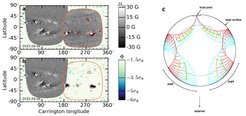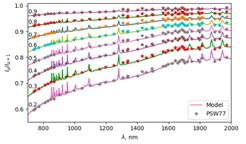Selected Major Results - Sun
Selected Recent Major Results:
- Observations of solar inertial modes
- Models of solar inertial modes
- The solar meridional circulation is one cell in each hemisphere
- Effect of magnetic fields on limb darkening
Observations of solar inertial modes
In Gizon et al. 2021, we reported that the spiral pattern in the high-latitude flows reported by Hathaway et al. (2013) is due to a global mode of oscillation in the inertial frequency range. This interpretation is based on the analysis of the m=1 power spectra of the longitudinal component of velocity at distinct latitudes (Figure. D). Irrespective of the latitude, we find excess power at the exact same frequency of ω0/2𝜋=−86 nHz in the Carrington frame (Fig. E). This is the signature of a global mode of oscillation. Other types of modes have been observed, with very different latitudinal profiles. The observations show that the latitude where the Rossby mode frequency vanishes in the frame rotating with the Sun’s differential rotation plays a critical role, leading to Rossby modes, critical latitude modes, and high-latitude modes.

In addition to their frequencies and surface eigenfunctions, the modes are observationally characterized by their lifetimes and amplitudes. One question is whether the mode amplitudes are modulated by the solar-cycle related changes, as is the case for p modes. If so, the inertial modes might inform us about the internal magnetic field and zonal flows, as well as their excitation and damping mechanisms. We are currently extending the observations to include the Mount Wilson Observatory time series of daily Dopplergrams, which predate helioseismology. As seen in Figure on the left, the m=1 mode has been present since 1969, providing us with the precious information over a full five solar cycles.
References:
- B. Löptien, L. Gizon, A.C. Birch, J. Schou , B. Proxauf, T.L. Duvall Jr, R.S. Bogart, U.R. Christensen (2018) Nat. Astron. 2, 568 [doi]
- L. Gizon, R.H. Cameron, Y. Bekki, A.C. Birch, R.S. Bogart, A.S. Brun, C. Damiani, D. Fournier, L. Hyest, K. Jain, B. Lekshmi, Z.-C. Liang, B. Proxauf (2021) Astron. Astrophys. 652, L6 [doi]
Models of solar inertial modes
In order to theoretically study the excitation of the linearly stable inertial modes, including the equatorial Rossby modes, Philidet & Gizon (2023) consider the forcing by stochastic fluctuations due to vortical convection. Using a 2D semi-analytical approach, it was found that the observed power spectra for these modes could be reproduced. It was also found that the power spectra at low latitudes often consist of a superposition of many unresolved modes, which complicates the interpretation of the observations.

Moving to 3-D, inertial modes in a spherical shell were investigated in a series of papers which formed the bulk of the thesis of Yuto Bekki. Amongst the many linear modes possible in the spherical shell, Bekki et al (2022a) were able to match the observed inertial modes. The effects of differential rotation, superadiabaticity, the value of the turbulent diffusivity, and a possible latitudinal entropy gradient on the modes were studied. It was found that the modes are sensitive to all these various ingredients, and it was suggested that the mode properties could be used to infer the structure of the solar interior. The linear eigenmodes are very close to the modes extracted from a fully nonlinear simulation of the convection zone (Bekki et al 2022b).
References:
- Bekki, Cameron, Gizon (2022a) Astron. Astrophys. 662, A16 [doi]
- Bekki, Cameron, Gizon (2022b) Astron. Astrophys. 666, A135 [doi]
- Bekki, Cameron, Gizon (2023), submitted [gdrive]
- Fournier, Gizon, Hyest (2022) Astron. Astrophys. 664, A6 [doi]
- Philidet & Gizon (2023) Astron. Astrophys. 673, A124 [doi]
The solar meridional circulation is one cell in each hemisphere
Photospheric magnetograms are the optimal data to be used for the validation and the calibration of far-side helioseismology. These have only recently become available for the far side thanks to the Solar Orbiter (SO) mission. Yang et al. (2023b) identified three magnetograms from PHI-FDT during the cruise phase and the beginning of the nominal operation phase of the SO mission (see Fig.a for an example), where a total number of six active regions were found on the far side. Contemporaneous helioseismic far-side maps were computed to Dopplergrams from SDO/HMI (see Fig. b for an example). We found that the few active regions identified on the far side are located in helioseismic maps at almost the same positions and with similar areas as in the SO/PHI magnetograms. This provides the strongest evidence so far that far-side helioseismology works extremely well.

Solar Orbiter has entered its nominal mission phase, and the SO/PHI synoptic program will provide magnetograms of the Sun from various vantage points with a cadence of multiple images per day. This means that many more active regions will be used in the future to calibrate the helioseismic far-side maps, which we may use to convert the signal from far-side helioseismology into active-region magnetic field strength. A statistically significant sample of active regions is necessary to properly assess the distributions of true and false positives and negatives. A 360-deg view of solar activity will also allow us to better study flux emergence, which is a major open problem.
References:
- Yang, L. Gizon, & H. Barucq (2023a), Astron. Astrophys. 669, A89 [doi]
- D. Yang, L. Gizon, & H. Barucq, et al. (2023b), Astron. Astrophys. 674, A183 [doi]
Effect of magnetic fields on limb darkening
Solar and stellar magnetic fields originate from both global dynamo and near-surface small-scale turbulent dynamo (SSD). The dependence of limb darkening on surface magnetic fields offers an exciting prospect for measuring the magnetization of stars. For the spatially-resolved Sun, the limb darkening can be measured directly, while for stars we can use transiting planets to sample their disks and extract their limb darkening. Recent analysis of Kepler data (Maxed 2023) has shown that non-magnetic models of stellar atmospheres fail to explain limb darkening of host stars, they all show an offset in limb darkening coefficients between observations and models.
Kostogryz et al. (2023b) computed the effects of magnetic field on limb darkening. We employed the 3D MHD-Radiative MURaM code (developed in the Sun and Heliosphere Department) to simulate the impact of magnetic field on solar photosphere and then utilized the MPS-ATLAS code to calculate the limb darkening.

The figure on the right shows solar intensity spectra for different center-to-limb positions for the quiet-Sun observations. In order to get a good agreement with the observations, the MURAM models had to include the self-consistently produced small-scale dynamo magnetic fields. The spectra are further perturbed by magnetic fields due to the global dynamo, including active regions. Including such fields allows the Kepler observations to be understood (Kostogryz et al. 2022, 2023a).
Thus accurate limb darkening models present the possibility of measuring small-scale and global magnetic fields using the limb darkening function derived using PLATO transits.
References:
- N.M. Kostogryz, A.I. Shapiro, V. Witzke, D. Grant, H.R. Wakeford, K.B. Stevenson, S.K. Solanki, and L. Gizon (2023a). MPS-ATLAS Library of Stellar Model Atmospheres and Spectra. Res. Notes American Astron. Soc. 7, 39
- N.M. Kostogryz, A.I. Shapiro, V. Witzke, R.H. Cameron, L. Gizon, N.A. Krivova, P.F.L. Maxted, S. Seager, S. K. Solanki, & J. Valenti (2023b). Stellar Surface Magnetic Fields Impact Limb Darkening, submitted
- N.M. Kostogryz, V. Witzke, A.I. Shapiro, S.K. Solanki, P.F.L. Maxted, R.L. Kurucz, and L. Gizon (2022). Stellar limb darkening. A new MPS-ATLAS library for Kepler, TESS, CHEOPS, and PLATO passbands. Astron. Astrophys. 666, A60



